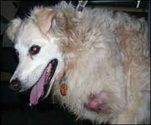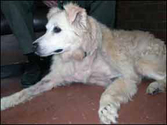Some are reluctant to perform surgery on old dogs because of anesthesia risks or complications, but these risks are minimal in the case of most lipomas. Modern anesthesia protocols are far safer than they used to be, and complications are generally minor, usually limited to superficial infection or delayed healing. There is no reason not to remove lipomas from older dogs when they interfere with their quality of life.

151
Tia Nelson examined a 12-year-old Lab whose owners had made the painful decision to put her down because she just couldn’t get around any more. But her problem wasn’t old age, it was a five-pound lipoma on her side just behind and partly under her shoulder blade. “I removed it,” says Dr. Nelson, “and the dog enjoyed another two years.”

167
In a report published on his blog “Your Pet’s Best Friend,” Everett Mobley, DVM, of Kennett, Missouri, describes the case of Ling Ling, a 15-year-old Collie-mix who developed a large tumor in front of her left shoulder. “It was about 6 inches long, 3 inches wide and 1.5 inches thick, which is pretty big, even for a 57-pound dog,” he says. “We did a fine-needle aspiration and it turned out to be a lipoma. Because Ling Ling was so elderly and the tumor was large enough to require lengthy surgery, plus it didn’t seem to bother her, we decided it was something she would probably die with, instead of something she would die from.”
But in May 2012, Ling Ling lost weight while her tumor grew.
“It grew so much,” says Dr. Mobley, “that it appeared to have disrupted its own blood supply. There was a nasty-looking bulge that looked like it would soon die and rot and burst open. Not so good. She made it through 90 minutes of surgery like a champ. The tumor was so big it was like delivering a baby. It weighed three pounds and was as big as her head.”
Because the mass had disrupted the attachment of Ling Ling’s shoulder muscles, Dr. Mobley re-attached them. She made a full recovery.





